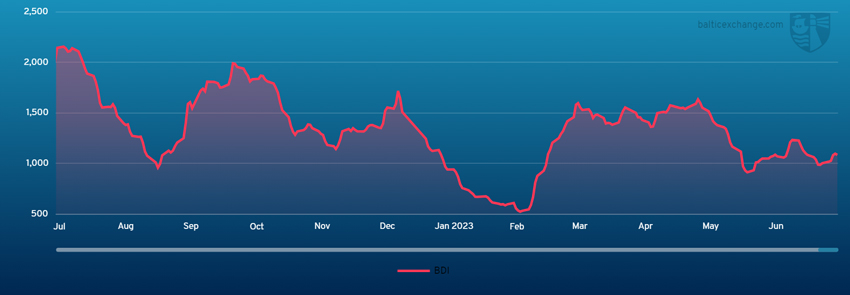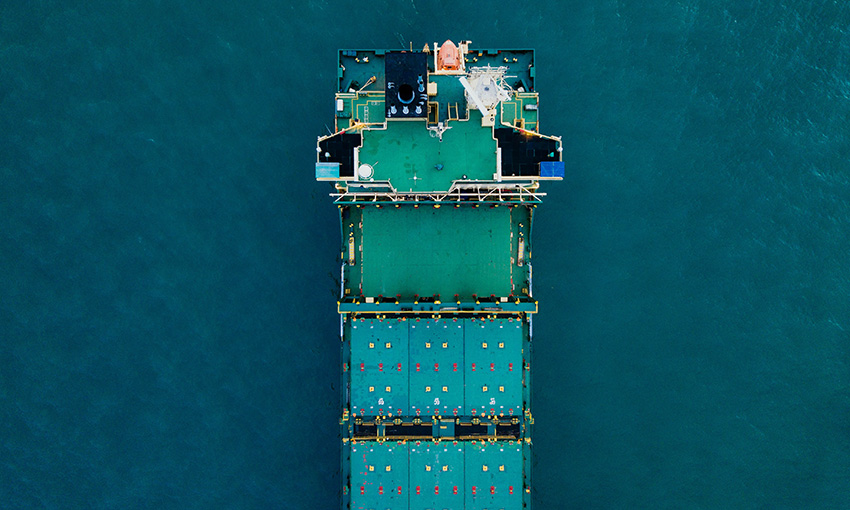THE BALTIC Dry Index has been inching up over the past week.
The index hit 1103 on Thursday, up from Monday’s 1024.
The BDI then went down slightly to end the week on 1090.

Capesize
This week began on a positive note in the Pacific market, with all three major players actively participating and securing vessels at more favourable rates. However, the momentum quickly dissipated and the market experienced a decline in rates as the week progressed, with a shift in sentiment due to a growing abundance of available vessels. The C5 market in particular experienced a decline compared to the beginning of the week. Similar downward pressure was observed in the South Atlantic market from Tubarao to China, with an increasing number of vessels in ballast, further impacting rates. By mid-week there was a stabilisation to the declining rates in the Pacific. The North Atlantic witnessed heightened activity, leading to increased volume and a scarcity of available tonnage, resulting in notable firm fixtures being concluded. As the week draws to a close, there has been continued downward pressure on rates in the Pacific. Meanwhile, in the Atlantic market, brokers expressed concerns that market conditions were shifting, possibly indicating an impending downturn. Overall, the week saw a mix of positive and negative market conditions, with fluctuations in rates and shifting sentiment. The availability of tonnage and the number of vessels in ballast were key factors influencing market trends.
Panamax
A week of positive gains for the Panamax market as the Atlantic market, both in the North and South, came to the fore once again, with EC South America absorbing tonnage worldwide, adding support to markets. The Atlantic did see better levels as the tonnage availability from the Continent and West Mediterranean tightened mid-week. From the South, a 75,000-dwt was fixed delivery EC South America end-July for a fronthaul at US$14,500 plus US$450,000 ballast bonus whilst an 82,000-dwt fixed delivery West Mediterranean for a trans-Atlantic run at US$13,000. In Asia a mixed week with the draw from EC South America owners hardened their ideas for Indonesian business, although further north tonnage levels remained high thus rates lacked impetus despite relatively healthy amount of cargo from the NoPac and Australian regions. An 82,000-dwt fixing delivery China mid-July for a trip via Australia redelivery Singapore-Japan at US$7,000. Period interest remained, an 82,000-dwt open South China fixing for a period until minimum 1 November 2024 to 15 January 2025 at US$12,500.
Ultramax/Supramax
A rather mixed affair for the sector over the week. The Atlantic generally remaining in the doldrums with limited fresh enquiry or excitement. The US Gulf region bucked this trend however as sentiment remained positive, although some said it was positional. A slightly more positive feel from Asia, with better levels of enquiry from Indonesia helping rates improve slowly. Although this was tempered by a limited amount of interest from the NoPac and Australian regions. Little in the way of period action, although a 63,000-dwt open WC India was heard fixed for four to six months trading at US$12,000. From the Atlantic, a 63,000-dwt was fixed for a trip from US Gulf to India at about US$16,000. Elsewhere, a 53,000-dwt fixed a trip from the East Mediterranean to West Africa at US$7,000. From Asia, a 56,000-dwt fixed delivery Singapore for a trip via Indonesia redelivery China at US$10,000. Whilst a 56,000-dwt was heard fixed from CJK via Australia redelivery Singapore-Japan at about US$6,500.
Handysize
The systematic erosion of levels across the sector continued with the ongoing lack of enquiry ensuing in a growing number of open vessels. On the Continent, a 34,000-dwt was fixed from North France to Morocco with an intended cargo of grains in the US$4,000s. A 34,000-dwt fixed basis delivery Çanakkale via Novorossiysk to Algeria at US$10,000, whilst at the end of the week a 32,000-dwt was fixed for a similar trip at US$7,000. In Asia, a 39,000-dwt opening in Taiwan was fixed via Indonesia to Vietnam with an intended cargo of coal in the mid-US$7,000s. A 40,000-dwt opening in Mikawa was fixed for a trip to the Mediterranean with an intended cargo of steels in the high US$7,000s and a 35,000-dwt opening in South China was fixed basis delivery in Indonesia to the Mediterranean in the low US$6,000s. A 35,000-dwt opening in Southeast Asia was fixed for eight to 10 months with worldwide redelivery in the US$8,000s.
Clean
LR2
MEG LR2 demand has been somewhat subdued this week. Subsequently TC1 has held stable in the WS100-102.5 range. TC20 has also followed suit, pegged all week in the US$2,800,000-2,900,000 region.
West of Suez, Mediterranean/East LR2’s remained sombre and a charter at US$2,300,000 reported fixed mid-week has guided the TC15 index to currently sit at this level for now.
LR1
In the MEG, LR1’s have suffered limited enquiry and plenty of available tonnage to accommodate same. TC5 came off 9.69 points to WS113.44 and similarly a TC8 dipped an incremental US$57,200 to US$2,442,700.
On the UK-Continent, TC16 continued to hover along at WS125 with little activity reported.
MR
MEG MR’s managed to recover early in the week as we saw TC17 resurge from WS179.64 to WS200, which has since resettled to WS196.43. An abundance of LR1’s has been cited to have put a cap on rates climbing further at time of writing.
UK-Continent MR’s have been undoubtedly soft this week. Freight rates have been tested down to varying levels with the dominant talking point around vessel trading histories. TC2 dipped 25 points to WS112.25 and similarly TC19 dropped from WS146.25 to WS123.44.
USG MR’s continued on a downward trajectory this week as a result of limited stems working in the Gulf. TC14 came down 12.09 points to WS107.08, TC18 dropped from WS204.17 to WS183.75 and a run to the Caribbean on TC21 lost US$47,917 to US$693,750. Despite this, TC18 and TC21 are still generating more than US$20,000/day round trip Baltic description TCE’s.
The MR Atlantic Triangulation Basket TCE dropped from US$22,036 to US$15,642.
Handymax
In the Mediterranean, after seeing TC6 hopping up to WS185 last week Handymax’s were recorrected back down to WS175.
Up on the UK-Continent, TC23 steadily climbed all week from WS129.72 to WS137.78.
VLCC
The market fell earlier in the week, bottomed and seemingly begun a slow climb. In the Middle East, Thai charterers put a 2004-built vessel on subs at WS50, demonstrating owners’ resistance. TD3C assessments dipped below WS50 on Wednesday and now the rate for 270,000 mt Middle East Gulf to China is still two points lower than last Friday at WS51.23 (a daily round-trip TCE of US$29,200 basis the Baltic Exchange’s vessel description), while the 280,000mt Middle East Gulf to US Gulf trip (via the cape/cape routing) is rated two points lower than a week ago at WS32.94.
In the Atlantic market, a similar situation prevails with the rate for 260,000 mt West Africa/China also dropping two points over the course of the week to WS51.15 (which shows a round voyage TCE of US$30,000/day). The rate for 270,000 mt US Gulf/China is now US$438,889 less than last Friday at US$7,411,111 (about US$27,400/day round trip TCE).
Suezmax
Suezmaxes have had a busier week, most notably in West Africa. For 130,000 mt Nigeria/Rotterdam rates hit a floor at the end of last week and now owners are clawing back the recent reductions gaining eight points to WS92.73 (a daily round-trip TCE of US$33,500). In the 135,000 mt CPC/Med market the rate slid a further nine points, with owners unsupported by a lack of cargo enquiry while tonnage remains well supplied, to WS97.63 (showing a daily TCE of US$31,900 round-trip) and in the Middle East the rate for 140,000 mt Basra/Lavera gained two points to WS56.4.
Aframax
In the North Sea, the rate for the 80,000 mt Hound Point/Wilhelmshaven rose three points to WS133.18 (showing a round-trip daily TCE of US$36,200, US$100/day less than last Friday’s). Meanwhile, in the Mediterranean, the 80,000 mt Ceyhan/Lavera rate lost a further six points over the week to WS122.33 (a daily round trip TCE of US$27,100).
Across the Atlantic, in the Stateside Aframax market, the rollercoaster ride is back in motion. The rate for 70,000 mt East Coast Mexico/US Gulf climbed 22.5 points to WS151.88 (which shows a TCE of about US$35,600/day round trip) and for 70,000 mt Covenas/US Gulf the rate is 16.5 points higher than last Friday at WS141.56 (a round-trip TCE of almost US$30,000/day). For the trans-Atlantic route of 70,000 mt US Gulf/Rotterdam the rate improved by 17 points to WS160.31 (a round trip TCE of US$35,500/day).
LNG
LNG spot has been particularly quiet this week, with demand for spot ships down. Reports of only cargo loading in the US for export in August with discharge Europe has kept rates flat. In the Pacific some enquires have been made but loading in Southeast Asia while Australia remains quiet. One other factor contributing to the overall lack of activity is that LNG 2023 has been on this week out in Vancouver where many market participants have been enjoying themselves. With the usual summer doldrums and particularly high storage of gas worldwide it was not expected that rates should do much other than hover.
Following the lack of open interest, rates did not move much, BLNG1g for Aus-Japan fell by US$340 to close at US$67,535. While in the Atlantic, US rates saw slightly larger falls with BLNG2g US-UK publish at a round voyage number of US$69,670 and US-Japan fell nearly US$2,000 to close at US$82,357.
LPG
Following quite a tumultuous week last week, LPG has taken a step back. The BLPG1 Ras Tanura-Chiba route was relatively flat this week in comparison, with only one report of a fixture done as a replacement. Rates themselves rates fell by US$4.143 to close at US$110.143, which gave a daily TCE return of US$97,320. Sentiment is flat and, though the direction could go either way, brokers feel there is a status quo for the moment between supply and demand.
It was a similar story in the US. Rates barely moved at all throughout the week losing just US$1 on BLPG3 Houston-Chiba to close at US$174.714 while BLPG2 Houston-Flushing gained US$1 to finish at US$102.4. This had minimal effect on the daily TCE earnings, which for an eastern run sit now at US$98,288 and for Houston-UKC a rise of US$608 gave a daily TCE earning of US$119,480. The tonnage list is looking tighter and delays in Panama are still on the radar, but so far this has not affected rates much.

